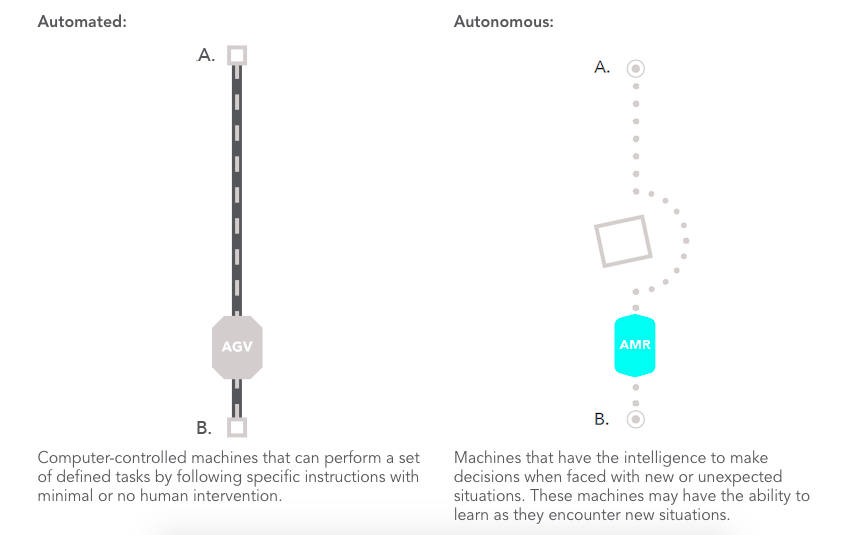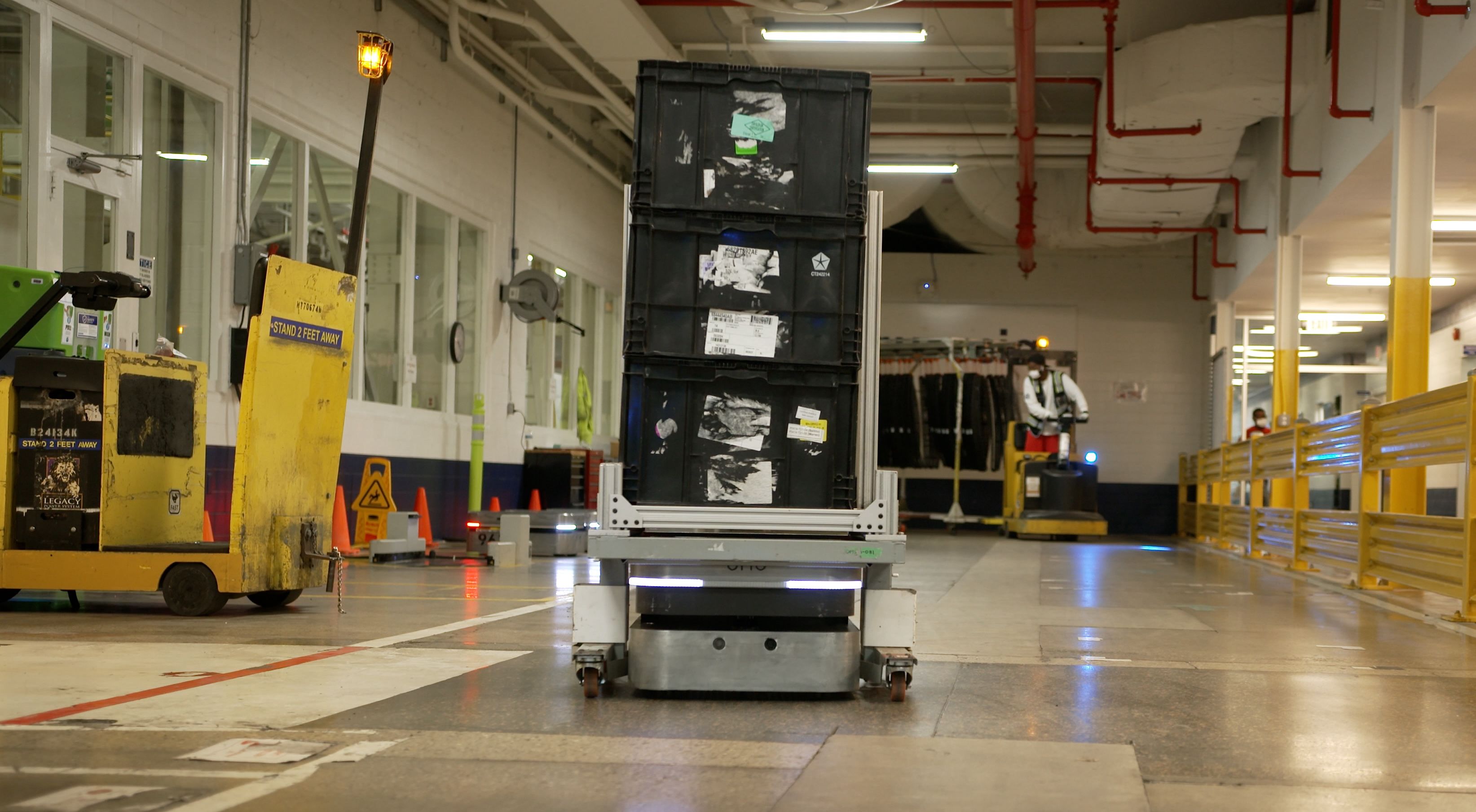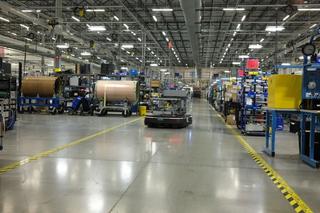Blog
3 reasons a Fortune 500 automotive parts manufacturer adopted AMR technology

As the 9th largest automotive parts manufacturer in the world, Faurecia is a household name in the automotive industry. The company designs and manufactures consoles, door panels, dashboards and more for 1 in 3 automobiles, supplying some of the world’s largest companies, including Ford, GM and Chrystler.
Automotive parts is a competitive industry, with factories worldwide that can already produce at a lower cost due to lower wage requirements. Additionally, many automotive factories in North America have already begun automating dangerous, repetitive tasks for many decades now.
In order to stay competitive and provide a low cost solution for their customers, Faurecia’s Interior Systems division in Fraser, Michigan, needed a reliable, small footprint material handling solution for timely deliveries with minimal downtime and hands-on support.
Their ultimate goal was to automate material movement between their warehouse and the workcells in their technology bay. To do this, Faurecia needed to evaluate all automation technologies in the market to find the best solution for their automotive workflows. Watch the video below for a snapshot of Faurecia’s automation journey:
Faurecia had three main drivers when choosing a solution. The automation selected must:
1. Increase plant efficiency without sacrificing safety
When Faurecia began evaluating automation technologies, the ability to continue manufacturing high quality products consistently and safely with improved efficiency was one of the top priorities. To stay competitive, Faurecia needed to reduce cycle times and improve response times.
First, Faurecia considered adding additional tuggers to their operation, but tuggers, they determined, are simply not safe enough for the requirements of an automotive plant. In fact, according to Faurecia, on average, tuggers resulted in 2-3 safety incidents every month. Tuggers also required extended engagement between operators and the workcell, impacting timely deliveries and thus efficiency metrics.
Next, Faurecia considered automated guided vehicles (AGVs) which simply would not improve efficiency as well as an autonomous mobile robot (AMR) since the AGV has to stop working entirely when something blocks its path.

Image 1: An AGV is stuck when an obstacle blocks its path, halting productivity, whereas an AMR has the ability to reroute and go around the obstacle, improving productivity.
For improved efficiency and safety, Faurecia ultimately decided to implement an AMR. The company chose OTTO Motors as the AMR provider for many reasons, including:
- OTTO is built for efficiency without compromise to safety of humans and other equipment.
- LiDar and 3D sensors continuously scan the environment while visual and audible signals communicate with humans.
- OTTO dynamically navigates obstructions in traffic areas, and limits unnecessary operator engagement with robots in the field.
With OTTO, we've been able to reduce the size of our floor space, and increase our manufacturing efficiency to make a better, cheaper product in order to bring home the profitability.
Chris Newby
Engineering Director, Faurecia Interior Systems
After over 1.5 years with OTTO AMRs, Faurecia has certainly increased efficiency without sacrificing safety. OTTO AMRs have achieved:
- Improved safety, including no near misses, accidents, or issues.
- Improved response times, delivering parts to operators at the touch of a button, which eliminates waiting times from delayed drivers and reduces workcell crowding.
- Standardized processes by predictably and reliably delivering the right amount of materials on time as needed. There’s no overstock or understock at any given time.
- Quick tracking of inefficiencies with real time data to enable investigation into bottlenecks and drive further plant improvements.
The OTTOs have safety features that allow them to coexist with a tugger, the operator, and people crossing its path. We’ve been running the OTTOs for about a year and a half and we’ve had zero safety incidents.
Chris Newby
Engineering Director, Faurecia Interior Systems

Image 2: An operator safely crosses the path of an OTTO 100. The OTTO 100 will safely stop when something or someone is in its path.
2. Reduce costs while increasing productivity
Another of Faurecia’s main goals was to improve competitiveness externally and internally by reducing costs and increasing productivity. To accomplish this, the company wanted to maximize floor space and eliminate small, micro-stoppages in the plant. When considering tuggers, once again, the size of the trailers would be too disruptive to the facility’s production cells.
AGVs, similarly, would be unable to drive right into workcells. Additionally, AGVs require facility reconfiguration to install magnetic strips, a high upfront cost that Faurecia did not want to undertake. AGVs are also unable to keep up with the inconsistencies of the plant day-to-day. Faurecia has a high volume of tuggers and operators that frequently leave boxes in the aisles. AGVs cannot autonomously drive around these boxes without operator intervention to remove the blockage, reducing productivity.
AMRs were ultimately the right choice to help reduce costs and increase productivity as well, but OTTO was specifically selected for many reasons, including:
- OTTO’s hands-off fleet management software, that is intuitive and easy to learn. Fleet Manager predictably moves materials around the facility, with only one hourly person needed to oversee the entire system from a tablet. Remapping and building routes is easy when required, and all robots can be located and tracked at all times with the software.

Image 3: With the click of a button on a tablet, Fleet Manager makes it easy for Faurecia to remap, build routes, call OTTOs, and track the robots.
- OTTO 100 is a small, powerful robot that is less disruptive to workcells, reduces the floor footprint, and engages with easily interchangeable carts. The workflow operation can remain seamless and consistent with OTTO, ensuring operator satisfaction.
Hands down, [operators] actually prefer OTTOs to the old delivery system.
Fred Eckert
Controls Engineer, Faurecia Interior Systems
- OTTO AMRs are robust and industrial grade, capable of driving alongside tuggers and forklifts in an unpredictable environment. OTTO is reliable and can withstand accidents and damage without breaking down.
It’s happened one or two times here at Faurecia where the OTTO has accidentally been hit by a tugger or a hi-lo. The OTTOs are so robust that if it does take a hit from a hi-lo or a tugger, it’s quick to reroute and complete the mission.
Julian Jarbo
General Manager, Faurecia Interior Systems
OTTO AMRs have delivered cost savings and productivity improvements for Faurecia, including:
- An 11-month return on investment
- A 15% reduction in work cell size
- A reduction in financial commitment for other equipment like unsafe forklifts and tuggers
3. Manage the labor shortage crisis without sacrificing flexibility
According to Deloitte and the Manufacturing Institute, while 4.6 million new manufacturing jobs are projected to be created by 2028, 2.4 million of them could go unfilled because of a skilled-labor shortage.
Faurecia wanted to redirect their people's workload to continue functioning efficiently amid the global labor shortage. Specifically, the company was looking for a low-maintenance standardized platform, capable of delivering small parts with consistency, that can be controlled by one to two hourly personnel without sacrificing the flexibility of manual work.
While automation in general would assist with the labor shortage challenge, AGVs do not provide the needed flexibility, as they cannot adjust and rework their path if it is blocked. Flexibility, thus, is the main reason Faurecia ultimately selected an AMR.
OTTO was selected as the AMR provider that could best manage the labor shortage crisis without sacrificing flexibility for many reasons, including:
- OTTO doesn’t take sick days, vacation days, or breaks. OTTO simply keeps working whenever it is needed, enabling the few available workers to focus on more rewarding, value-added tasks.
OTTO allows us to reduce our tugger drivers and hi-lo drivers, utilizing the manpower in a much more efficient way.
Fred Eckert
Controls Engineer, Faurecia Interior Systems
- OTTO always answers the phone, eliminating the need for facility personnel to focus on the robots. OTTO Motors service and support is available 24/7 for quick resolution of any challenges that arise. Faurecia was impressed with OTTO’s unique service-oriented business approach, unlike other AMR providers.

Image 4: OTTO 100 works in Faurecia’s factory without operator intervention, helping the company move toward lights-out manufacturing and combating the labor shortage.
OTTO has helped Faurecia combat the labor shortage crisis while remaining flexible:
- OTTO AMRs work consistently without intervention, helping Faurecia achieve 24/6.5 operations
- As of September 2021, OTTO has completed 49k missions and 20k fleet kilometers driven
- 3 OTTOs replace one material handler per shift, enabling a relocation of skilled labor
[OTTO AMRs] operate 24 hours a day, 7 days a week, and they don't take breaks, nor do they show up late for work or get sick.
Chris Newby
Engineering Director, Faurecia Interior Systems
Faurecia Interior Systems has seen such success with OTTO AMRs that they are even providing tours for other Faurecia plants to display their efficiency and productivity gains.
Faurecia executives have fully supported the initiative and are dedicated to digital transformation. They are impressed with the proven results of the facility today and are pushing for expansion tomorrow.
While Faurecia currently has eight OTTO 100s at their Michigan facility, four more are being added to the fleet. Faurecia and OTTO Motors have a bright future together as they continue to automate material handling in the automotive industry.






